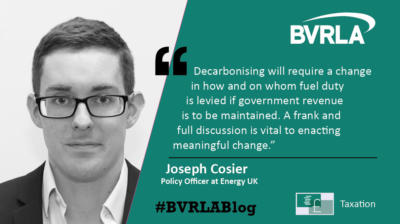Joseph Cosier, Policy Executive at Energy UK, the trade association for the British energy industry, shares his views on why tax reform is needed to encourage drivers to transition from internal combustion engine to low carbon vehicles.

The power sector has led the way in reducing carbon emissions in the UK economy with three quarters of emissions reductions since 2012 coming from energy generators, meaning powering our cars with electricity is now the cleanest choice to make.
However, alongside this progress new questions are emerging, not least the issue of how to ensure that the tax system can keep pace with the rapid transition from internal combustion engine vehicles to electric vehicles (EVs).
While financial support from government has been vital to the growth of the UK EV market to date, I’m confident that the market can, and will, be able to support itself over the longer term. To achieve this, subsidy removal should be signposted well in advance and be clearly linked with increases in EV market share and like for like comparisons of upfront cost of vehicles.
There is also a strong case for subsidising a network of ultra-rapid chargers to help overcome range anxiety, still one of the biggest barriers to EV adoption. In Energy UK’s recent thought piece on decarbonising road transport – as part of the Future of Energy report – this is one of the key recommendations.
Although, in my opinion, the retention of incentives and exemptions can form only part of the discussion.
EV drivers do not currently pay either fuel duty or VED, meaning that decarbonising will require a change in how and on whom fuel duty is levied if government revenue is to be maintained. This is a politically sensitive topic, but a frank and full discussion is vital to enacting meaningful change.
Energy UK has proposed three primary criteria that should be applied when assessing our future vehicle tax system:
- Does it encourage drivers to transition from internal combustion engine vehicles to EVs?
- Does it introduce incentives to avoid driving on congested roads? As EVs come to outnumber conventional vehicles, the climate change and air quality imperative will lessen, one problem that will persist is congestion and congestion costs the UK economy billions per year.
- Does it abide by the ‘polluter pays’ principle? Those responsible for negative impacts on climate change, air quality or congestion, should pay in proportion to the damage caused.
When considering this final point, it is important that the costs paid by drivers are clearly linked to mileage, which excludes methods that transfer fuel duty onto, for example, general taxation or electricity bills. Levies on electricity bills are paid by all consumers, regardless of ability to pay or whether they own a vehicle. This makes transferring fuel duty onto electricity bills a highly regressive approach to taxation.
Various alternatives have been suggested, including making greater use of congestion charging zones and toll roads, amending fuel duty and, more radically, introducing a national model of road pricing, where the per mile charge is paid by the driver.
In terms of practical next steps, there is currently no clear winner, hence we need to trial different solutions to understand what works best in practice.
The Road to Zero: time to shift gear on tax report, commissioned by the BVRLA, kicks off a much-needed discussion on how to reform the tax system and support the uptake of EVs.
While challenging, reforming long-term transport fiscal policy cannot be delayed further and steps need to be taken now to prepare the way for change further down the line. It is clear to me that more of the same is not an option.





